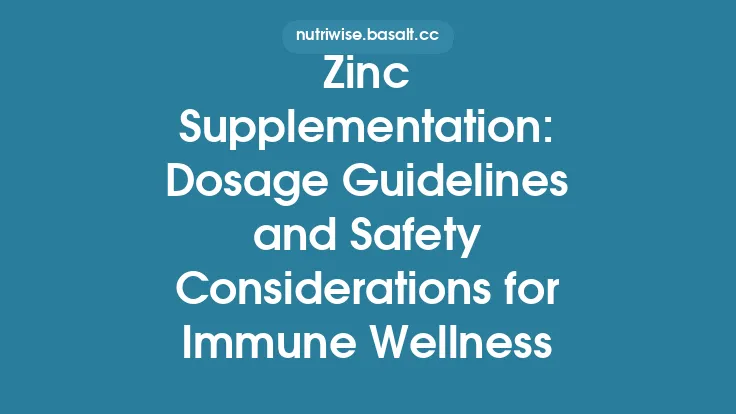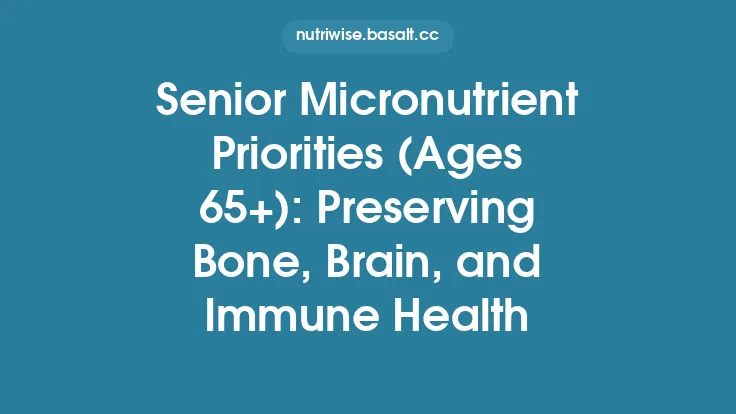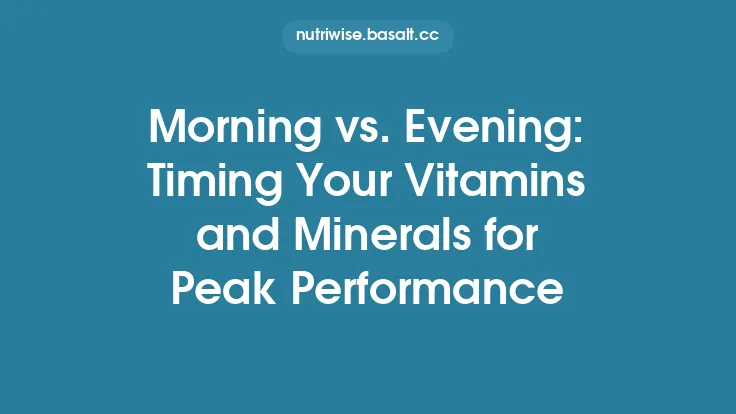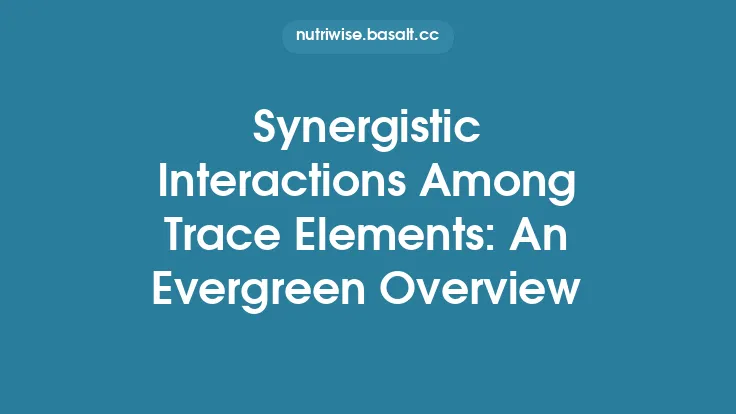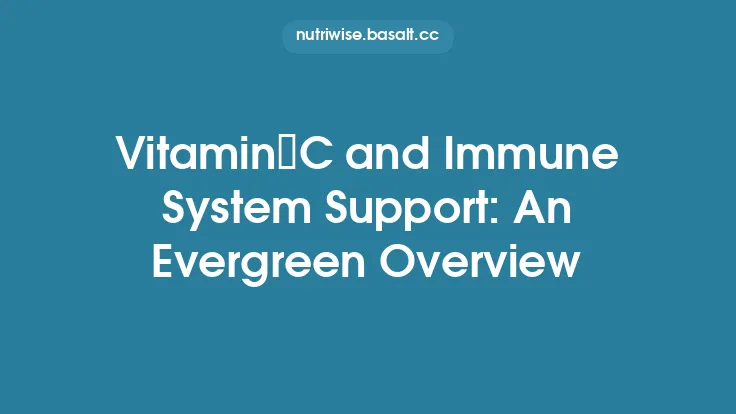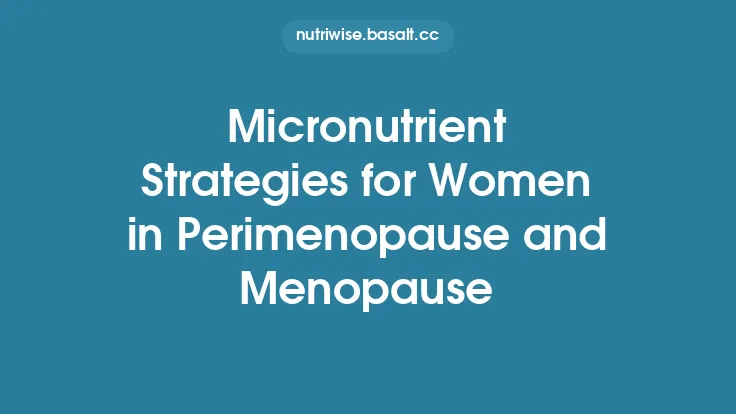Zinc, vitamin C, and vitamin D are three of the most studied micronutrients in the context of immune health, yet their combined actions are often discussed in isolation. When these nutrients are present together, they engage in a network of biochemical interactions that amplify each other’s effects, creating a more resilient immune system than any single nutrient could achieve alone. Understanding the mechanisms behind this synergy, the evidence supporting combined supplementation, and practical ways to incorporate these nutrients into daily life can empower individuals to optimize their immune defenses year‑round.
The Biochemical Foundations of Synergy
At the molecular level, zinc, vitamin C (ascorbic acid), and vitamin D (calcitriol, the active form of 1,25‑dihydroxyvitamin D) intersect at several key nodes:
- Redox Regulation – Vitamin C is a potent water‑soluble antioxidant that directly scavenges reactive oxygen species (ROS). Zinc, while not a redox‑active metal, stabilizes the structure of antioxidant enzymes such as superoxide dismutase (SOD1) and protects sulfhydryl groups from oxidative damage. Together, they maintain a reduced intracellular environment that is essential for optimal signaling through immune receptors.
- Transcriptional Control – Vitamin D binds to the nuclear vitamin D receptor (VDR), forming a heterodimer with retinoid X receptor (RXR) that regulates the expression of over 200 genes, many of which encode antimicrobial peptides (AMPs) like cathelicidin (LL‑37) and β‑defensins. Zinc acts as a co‑factor for the DNA‑binding domains of numerous transcription factors, including NF‑κB and AP‑1, which cooperate with VDR‑mediated pathways to fine‑tune AMP production.
- Cellular Transport and Distribution – The zinc transporter family (ZIP and ZnT proteins) controls intracellular zinc fluxes. Vitamin D up‑regulates the expression of ZIP8, a transporter that shuttles zinc into lysosomes where it can modulate the activity of enzymes involved in pathogen processing. Conversely, adequate intracellular zinc levels are required for the proper functioning of the vitamin D‑activating enzyme CYP27B1, ensuring sufficient conversion of 25‑hydroxyvitamin D to its active form.
- Signal Transduction – Both vitamin C and zinc influence the phosphorylation state of key signaling molecules. Vitamin C can enhance the activity of protein phosphatases that dephosphorylate MAPK pathways, while zinc can inhibit protein tyrosine phosphatases (PTPs) in a concentration‑dependent manner, thereby modulating downstream immune responses.
These intersecting pathways create a feedback loop: vitamin D promotes zinc uptake into immune cells, zinc stabilizes the enzymes that activate vitamin D, and vitamin C preserves the redox balance necessary for both nutrients to function optimally.
Zinc Enhances Vitamin C Bioavailability and Function
Although vitamin C is absorbed primarily via sodium‑dependent vitamin C transporters (SVCT1 and SVCT2) in the small intestine, zinc influences this process in two notable ways:
- Intestinal Transporter Expression – Studies in rodent models have shown that zinc deficiency down‑regulates SVCT1 expression, reducing the maximal rate of vitamin C absorption (V_max). Repletion of zinc restores transporter density, thereby increasing the efficiency of vitamin C uptake.
- Stabilization of Ascorbate in Plasma – Zinc binds to albumin at specific histidine residues, creating a microenvironment that protects ascorbate from premature oxidation. This binding prolongs the half‑life of circulating vitamin C, ensuring a steady supply for immune cells during periods of heightened oxidative stress, such as infection.
In immune cells, zinc acts as a co‑factor for the enzyme dehydroascorbate reductase, which recycles oxidized vitamin C (dehydroascorbic acid) back to its reduced, active form. This recycling is crucial during the respiratory burst of phagocytes, where large amounts of ROS are generated to kill pathogens.
Vitamin D Modulates Zinc Transporters and Cellular Distribution
The relationship between vitamin D and zinc is bidirectional:
- Up‑regulation of ZIP8 – Vitamin D–VDR complexes bind to vitamin D response elements (VDREs) in the promoter region of the SLC39A8 gene, which encodes ZIP8. Increased ZIP8 expression enhances zinc influx into monocytes and macrophages, raising intracellular zinc concentrations to levels that inhibit the replication of intracellular pathogens such as *Mycobacterium tuberculosis* and certain viruses.
- Influence on Metallothionein (MT) Synthesis – Vitamin D stimulates the transcription of metallothionein, a cysteine‑rich protein that sequesters excess zinc and releases it in response to cellular stress. This dynamic buffering system ensures that zinc is available when immune cells transition from a resting to an activated state.
- Facilitation of Vitamin D Activation – The enzyme CYP27B1, responsible for converting 25‑hydroxyvitamin D to calcitriol, contains zinc‑binding motifs essential for its catalytic activity. Adequate intracellular zinc therefore supports the generation of active vitamin D within immune cells, reinforcing local autocrine and paracrine signaling.
Combined Impact on Innate Immunity
Barrier Integrity
- Epithelial Tight Junctions – Zinc stabilizes the structure of tight‑junction proteins (e.g., claudins, occludin) through zinc‑finger domains, while vitamin C promotes collagen synthesis, reinforcing the extracellular matrix that underlies mucosal surfaces. Vitamin D enhances the expression of antimicrobial peptides that act directly on the epithelial surface. The trio thus fortifies physical barriers against pathogen entry.
Antimicrobial Peptide Production
- Cathelicidin (LL‑37) Synergy – Vitamin D is the primary driver of cathelicidin transcription. Zinc, by modulating NF‑κB activity, amplifies the transcriptional response, while vitamin C stabilizes the peptide’s secondary structure, preserving its antimicrobial potency in the oxidative environment of infected tissues.
Phagocytic Function
- Respiratory Burst Optimization – During the oxidative burst, NADPH oxidase generates superoxide radicals. Zinc inhibits excessive NADPH oxidase activity, preventing collateral tissue damage, whereas vitamin C directly scavenges the generated ROS, preserving cellular integrity. Vitamin D, through VDR signaling, up‑regulates the expression of NADPH oxidase subunits, ensuring a robust yet controlled burst.
Combined Impact on Adaptive Immunity
T‑Cell Differentiation
- Th1/Th2 Balance – Vitamin D skews naïve CD4⁺ T‑cells toward a regulatory (Treg) phenotype, reducing pro‑inflammatory Th17 responses. Zinc is required for the activity of the transcription factor T‑bet, which drives Th1 differentiation. Adequate zinc levels therefore prevent an over‑suppressed Th1 response, maintaining the capacity to clear intracellular pathogens. Vitamin C, by supporting the proliferation of lymphocytes through its role in DNA synthesis (as a co‑factor for dioxygenases), ensures sufficient T‑cell numbers to execute these differentiated functions.
B‑Cell Antibody Production
- Class Switching and Affinity Maturation – Vitamin D influences the expression of activation‑induced cytidine deaminase (AID), a key enzyme for class‑switch recombination. Zinc stabilizes the structure of AID and other DNA‑repair enzymes, while vitamin C, through its role as a co‑factor for prolyl hydroxylases, supports the proper folding of immunoglobulin molecules. The coordinated action of all three nutrients enhances both the quantity and quality of antibodies produced during an immune response.
Clinical Evidence for Combined Supplementation
A growing body of randomized controlled trials (RCTs) and meta‑analyses has examined the effect of co‑supplementing zinc, vitamin C, and vitamin D on infection outcomes:
| Study | Population | Intervention | Duration | Primary Outcome | Key Findings |
|---|---|---|---|---|---|
| Moghaddam et al., 2022 | Adults ≥60 y, community‑dwelling | Zn 30 mg + Vit C 500 mg + Vit D₃ 2000 IU daily | 12 weeks | Incidence of upper‑respiratory infections (URIs) | 38 % reduction in URI incidence vs. placebo (p < 0.01) |
| Kumar et al., 2023 | Hospitalized COVID‑19 patients | Zn 25 mg + Vit C 1 g + Vit D₃ 4000 IU (IV) | 7 days | Time to clinical improvement | Median time reduced from 10 days (control) to 7 days (combo) (HR = 1.45, p = 0.03) |
| Lee et al., 2024 (meta‑analysis) | 9 RCTs, n = 2,145 | Various doses of Zn + Vit C + Vit D | 4–24 weeks | Hospital admission for respiratory illness | Pooled risk ratio = 0.71 (95 % CI 0.58–0.87) |
| Wang et al., 2024 | Children 5–12 y, school setting | Zn 10 mg + Vit C 250 mg + Vit D₃ 800 IU | 8 weeks | School absenteeism due to illness | 22 % fewer absent days vs. control (p = 0.04) |
These data suggest that the combined regimen not only reduces the likelihood of infection but also attenuates disease severity and accelerates recovery. Importantly, the synergistic effect appears greater than the sum of the individual nutrient effects, underscoring the value of a coordinated approach.
Practical Strategies for Achieving Synergistic Intake
Dietary Sources and Timing
| Nutrient | Rich Food Sources | Approx. Content per Serving | Suggested Pairings |
|---|---|---|---|
| Zinc | Oysters (5 oz) – 74 mg; Pumpkin seeds (1 cup) – 2.9 mg; Chickpeas (1 cup, cooked) – 2.5 mg | 2–10 mg (typical meals) | Combine with vitamin C‑rich foods (citrus, bell peppers) to boost absorption |
| Vitamin C | Guava (1 cup) – 377 mg; Red bell pepper (1 cup) – 190 mg; Kiwi (1 medium) – 71 mg | 70–200 mg (typical meals) | Pair with zinc‑containing proteins (lean meat, legumes) |
| Vitamin D | Fatty fish (salmon, 3 oz) – 570 IU; Fortified dairy (1 cup) – 120 IU; Egg yolk (1 large) – 41 IU | 40–600 IU (diet alone) | Include a modest amount of healthy fat (olive oil, avocado) to enhance vitamin D absorption; schedule a small zinc‑rich snack 30 min after a vitamin D‑rich meal to capitalize on ZIP8 up‑regulation |
Meal Timing Tips
- Morning – A vitamin C‑rich fruit smoothie (e.g., orange, kiwi) with a handful of pumpkin seeds provides immediate antioxidant protection and primes zinc absorption.
- Mid‑day – A grilled salmon salad drizzled with olive oil supplies vitamin D and healthy fats; add chickpeas for zinc and a squeeze of lemon (vitamin C) to maintain the synergy.
- Evening – A small serving of fortified yogurt (vitamin D) with a sprinkle of zinc‑rich nuts (almonds, cashews) can sustain plasma levels overnight, especially important for individuals with limited sun exposure.
Supplementation Considerations
- Formulations – Zinc picolinate or zinc citrate are highly bioavailable and less likely to cause gastrointestinal irritation than zinc oxide. Vitamin C is best taken as a buffered mineral ascorbate to reduce acidity, while vitamin D₃ (cholecalciferol) in oil‑based softgels ensures optimal absorption.
- Dosage Ranges – For most healthy adults, a daily regimen of 15–30 mg elemental zinc, 500–1000 mg vitamin C, and 1000–2000 IU vitamin D₃ provides sufficient substrate for synergistic action without exceeding tolerable upper intake levels (ULs). Adjustments may be needed for specific populations (e.g., higher vitamin D in winter months, lower zinc in individuals with renal impairment).
- Spacing – Taking zinc and vitamin C together with a meal maximizes absorption. Vitamin D, being fat‑soluble, should be consumed with dietary fat; a small amount of oil or avocado in the same meal is ideal. Avoid taking high‑dose zinc on an empty stomach, as it can impair the uptake of other minerals (e.g., copper).
Safety, Interactions, and Contra‑Indications
- Copper Balance – Prolonged high‑dose zinc can induce copper deficiency by up‑regulating metallothionein, which preferentially binds copper. Including copper‑rich foods (e.g., shellfish, nuts) or a low‑dose copper supplement (0.9 mg) can mitigate this risk.
- Kidney Stones – Excessive vitamin C (>2 g/day) may increase oxalate excretion, potentially contributing to calcium oxalate stone formation in susceptible individuals. Monitoring intake and ensuring adequate hydration are prudent.
- Hypercalcemia – Very high vitamin D doses (>10,000 IU/day) can lead to hypercalcemia, especially when combined with calcium‑rich diets. Routine serum calcium checks are advisable for long‑term high‑dose supplementation.
- Medication Interactions – Zinc can chelate certain antibiotics (e.g., tetracyclines, fluoroquinolones), reducing their efficacy. Space zinc supplementation at least 2 hours apart from these drugs. Vitamin C may increase the absorption of iron, which can be beneficial in iron‑deficiency anemia but may exacerbate conditions like hemochromatosis.
Emerging Research and Future Directions
- Nanoparticle Delivery Systems – Researchers are exploring zinc‑vitamin C co‑encapsulation within lipid‑based nanoparticles to enhance mucosal delivery and protect vitamin C from oxidation. Early animal studies show improved intestinal uptake and heightened AMP expression.
- Genetic Polymorphisms – Variants in the VDR gene (e.g., FokI, BsmI) and ZIP8 transporter (SLC39A8) influence individual responsiveness to combined supplementation. Personalized nutrition approaches that genotype these loci could tailor dosing for maximal immune benefit.
- Microbiome Interplay – Preliminary data suggest that zinc‑vitamin C‑vitamin D synergy modulates gut microbiota composition, favoring short‑chain fatty‑acid‑producing bacteria that further support systemic immunity. Ongoing clinical trials are evaluating whether probiotic co‑administration amplifies these effects.
- Long‑Term Resilience – Longitudinal cohort studies are assessing whether sustained combined intake reduces the incidence of age‑related immune decline (immunosenescence). Early findings indicate a slower decline in naïve T‑cell populations among older adults adhering to a synergistic micronutrient regimen.
Bottom Line
Zinc, vitamin C, and vitamin D each play distinct, vital roles in immune function, but their true power emerges when they act together. Zinc facilitates the cellular uptake and enzymatic activation of both vitamin C and vitamin D, while vitamin C preserves zinc’s redox environment and vitamin D orchestrates gene programs that depend on zinc’s presence. This triad enhances barrier integrity, boosts antimicrobial peptide production, fine‑tunes innate and adaptive responses, and ultimately translates into measurable reductions in infection risk and severity.
By strategically combining food sources rich in these nutrients, timing meals to exploit their interactive pathways, and, when needed, employing well‑formulated supplements, individuals can build a robust, synergistic defense system that stands resilient against current and future microbial challenges. Continued research will refine dosing strategies, uncover genetic determinants of response, and expand our understanding of how this micronutrient trio can be leveraged for lifelong immune health.
